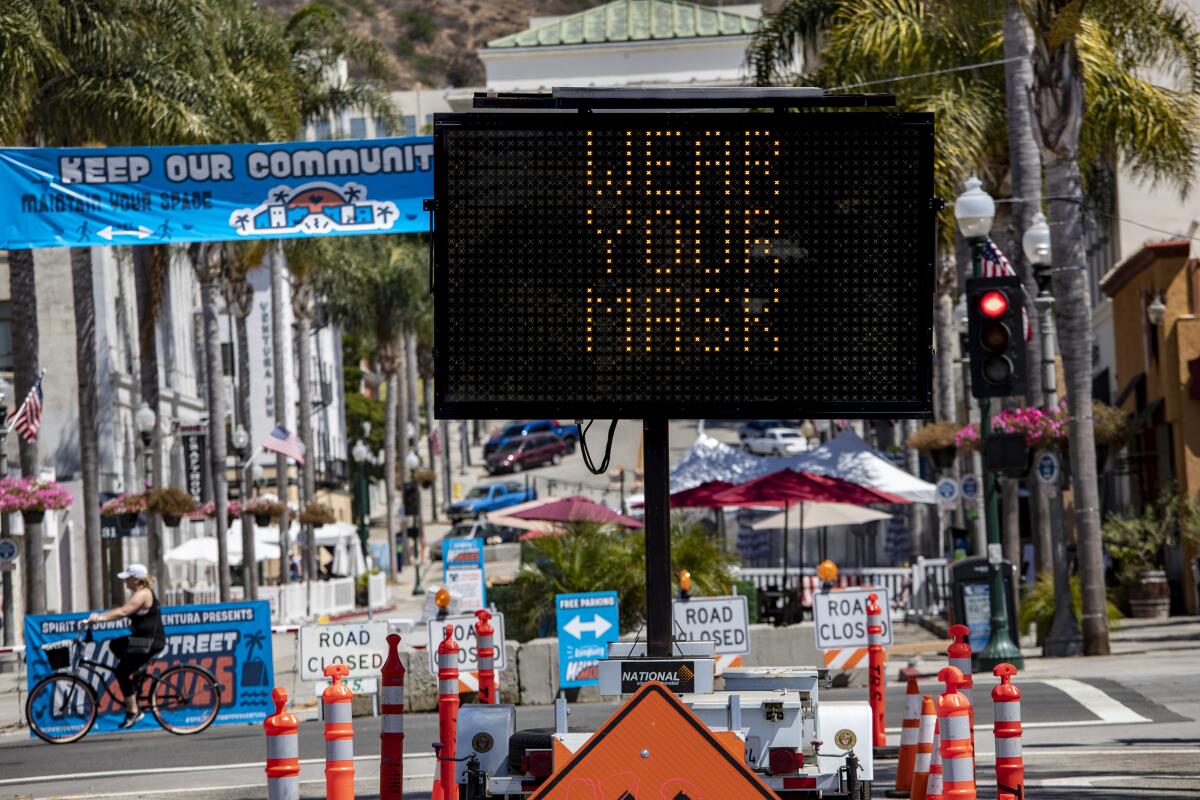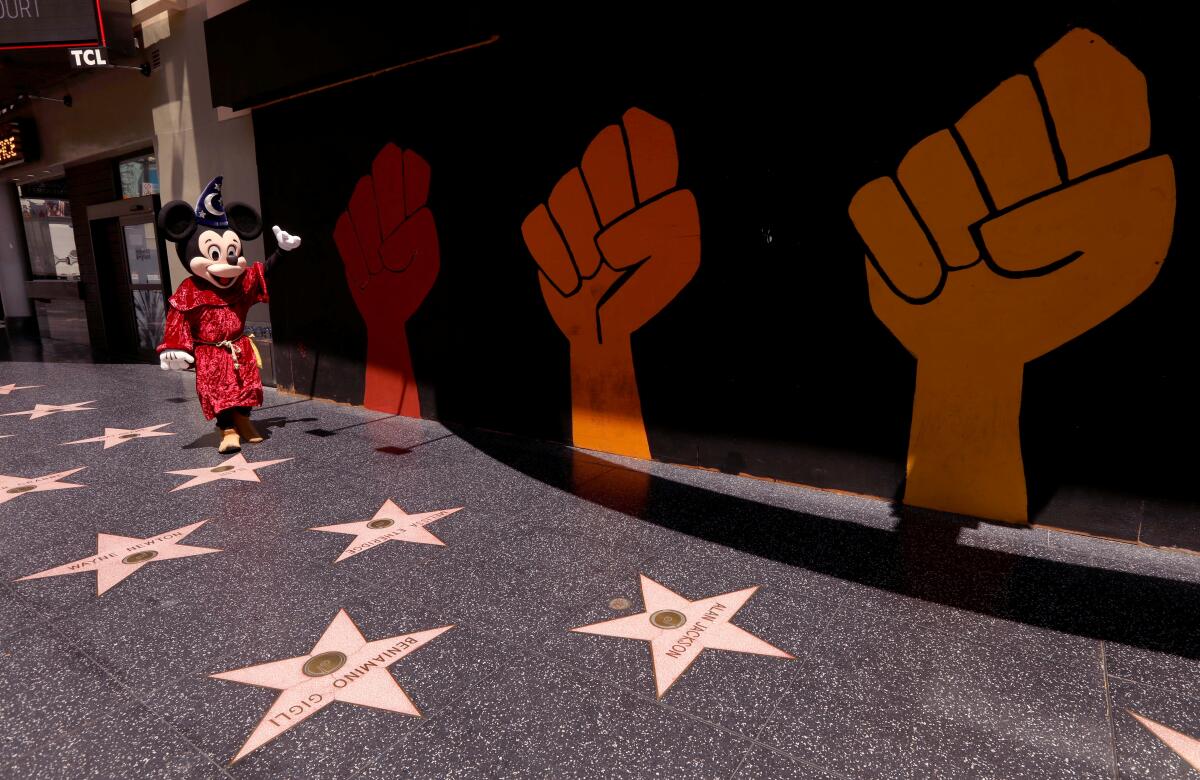Newsletter: Glimmers of hope in state coronavirus battle

- Share via
Good morning, and welcome to the Essential California newsletter. It’s Tuesday, Aug. 4, and we’re back with another edition of the eternal (or at least five-month-old) question: Where do we currently stand in the long battle between California and the coronavirus?
Sign up for Essential California
The most important California stories and recommendations in your inbox every morning.
You may occasionally receive promotional content from the Los Angeles Times.
The month of July was a rough one for the state, as Gov. Gavin Newsom clamped down restrictions while the coronavirus surged. Rising hospitalizations and deaths followed the soaring case counts. Over the course of the month, California broke its single-day record for deaths five times, with three of those record-setting days occurring last week.
But the state appears to be gaining a bit of ground in its battle against the virus, with Newsom announcing “some early good signs” during his briefing Monday. California is far from in the clear, and some areas, like the Central Valley, are still seeing surging numbers.
[Read the story: “California has the most coronavirus cases of any state, but there are signs of hope, Newsom says” in the Los Angeles Times]
A look at the modest gains, and what they mean:
The number of people hospitalized statewide has fallen about 10% over two weeks, and admissions to intensive-care units have fallen by 5%, Newsom said Monday. The number of people hospitalized for COVID-19 in Los Angeles and Orange counties also dropped over the last week.
As of Monday, the statewide seven-day average of new cases was down 21% from the previous seven-day average, falling from more than 9,800 to 7,764. “That’s good news,” Newsom said. The case positivity rate — or the percent of people testing positive for the coronavirus — is also declining. Even as testing continues to increase in the state, the 14-day case positivity rate is at about 7%, and the 7-day positivity rate is even lower, coming in just above 6%.
To be clear, “good” remains a relative thing here. That case positivity rate is “still too high,” Newsom said. (For reference, the World Health Organization has advised governments that case positivity rates should remain at 5% or lower for at least two weeks before reopening.) But even if we are not yet where we need to be, downward trends are still far preferable to upward ones, particularly after so many weeks of watching numbers climb.
Newsom attributed the modest improvements to better adherence to mask rules and social distancing and new “very, very difficult” state rules that shut down bars, restaurants and other industries.
Hot spots, and the road ahead:
These statewide numbers do not reflect the grim reality in the Central Valley, which Newsom identified as the current “biggest area of concern” in California. Eight counties in the Central Valley have seen hospitalization and infection rates that far outstrip the rest of the state.
Looking more broadly across the state, 38 of California’s 58 counties remain on the state monitoring list. As my colleague Laura Nelson explains in her story, roughly 97% of the state’s population resides in those 38 counties — a list that includes every county in the Bay Area and in Southern California.
“The overall trend — positivity rates, hospitalizations, now ICUs — is showing a decrease from where we were over a week ago. Encouraging signs,” Newsom said. But, he continued, we have not yet seen a long enough decline for Californians to feel confident in the gains. “We’ll need to see another few weeks of this kind of data to come in to feel more confident about where we are as a state.”
So, what comes next? It’s critical to remember that these downward numbers reflect behavior from roughly two weeks ago, and a bit longer when looking at hospitalizations. In the face of what had been a dramatic surge, statewide vigilance and renewed closures appear to have slightly stemmed the rising tide, at least for now. But the waters ahead remain vast and punishing, and they will come rushing right back at us the moment we let up.
“We can quickly find ourselves back to where we were just a few weeks ago, a month ago, with significant increases if we do not maintain our vigilance, if we do not maintain our focus,” Newsom said. “This virus is not going away.”
And now, here’s what’s happening across California:
LAUSD and the teachers’ union have reached a tentative deal for more predictable remote learning schedules for students: Even though they will be at home, Los Angeles students will have a learning schedule that resembles a regular school day when the fall semester starts in two weeks, under a tentative agreement over rules for instruction reached by teachers and the district. The official school day — which will include daily live online interaction, small group work and independent work as well as time to focus on the social and emotional needs of students — would last from 9 a.m. until 2:15 p.m. Classroom teachers are expected to work an average of six hours per day, which means that some work is expected to take place outside of the set schedule. Los Angeles Times
A car malfunction sparked the massive Apple fire, which has now charred more than 26,000 acres in the Inland Empire. Crews battling the blaze, which is burning north of Cherry Valley in Riverside County, have had to contend with challenging weather conditions. As of Monday evening, the fire was 5% contained. Los Angeles Times
L.A. STORIES
Sidewalk superheroes and the rest of the Hollywood Boulevard economy are being devastated by the coronavirus. Mascots roam near-empty streets as the virus spells trouble for one of L.A.’s most iconic blocks. Los Angeles Times

Art is a force for community empowerment in South L.A. The Crenshaw Dairy Mart, Residency Art Gallery and new community center Summaeverythang are part of a lineage dating back at least 50 years to the Black Arts Movement. Hyperallergic
Instagram accounts recount racism at L.A.’s elite private schools. In an outpouring born of the national Black Lives Matter movement, current and former L.A. private school students talk of their encounters with bias, exclusion and microaggressions at schools where annual tuition can run as high as $40,000, and class sizes can be as low as 15 students. Los Angeles Times
BCD Tofu founder Hee-sook Lee has died. Here’s my colleague Victoria Kim’s 2008 profile of the Korean immigrant and her small empire of stew. Los Angeles Times
Support our journalism
POLITICS AND GOVERNMENT
The Census Bureau will rush to complete its count by Sept. 30, a month earlier than planned. Only 63% of the nation’s estimated 121 million households have responded to the 2020 Census by mail or phone or online. The last-minute change to the timeline raises concerns about the accuracy of the count, which is used to determine representation in Congress and state legislatures. (Haven’t been counted yet? It’s not too late! Respond here.) Los Angeles Times
President Trump said TikTok will have to close in the U.S. by Sept. 15 — unless there’s a deal to sell the social network’s domestic operations to Microsoft Corp. or another U.S. company. Trump also said the federal government will have to be paid a “substantial amount of money” as part of any deal. Los Angeles Times
[Previously: “Promising a TikTok ban, Trump escalates tech war with China” in the Los Angeles Times]
Before the pandemic, being a California legislator meant globetrotting perks for many. The global travel bills were often footed by groups that critics say are usually looking to sway lawmakers to their causes. Associated Press
California has lost a greater share of revenue due to COVID-19 than many other states. California’s progressive tax structure means state revenue does well in good economic times but suffers more than most other states when there’s a downturn. NPR
CRIME AND COURTS
San Diego is punishing speech using a 102-year-old city law. Since 2013, San Diego police officers have issued 83 tickets for “seditious” language. One man says he was cited for singing rap lyrics; another was ticketed inside his own home. Voice of San Diego
HEALTH AND THE ENVIRONMENT
Some autopsies remain secret for years. Families of those killed by police want that changed. Los Angeles Times
CALIFORNIA CULTURE
Like everyone else, professional foragers have to pivot their business model during the pandemic. A woman who once made a comfortable living foraging wild fruits and herbs and selling them to top restaurants has seen demand evaporate. Her solution? Go direct to the customers by pairing her wild food add-ons to a weekly CSA subscription box. LAist
The NBA G League has decided to base its new Pro Pathway team in Walnut Creek. The league had considered basing its G League Select Team in Los Angeles, but it ultimately decided on Walnut Creek — a Bay Area suburb just 24 miles northeast of the Golden State Warriors’ home arena. San Francisco Chronicle
San Diego’s century-old “Museum of Man” has changed its name to the more inclusive “Museum of Us.” The shift is a reflection of a broader effort by the cultural anthropology museum to redefine its role in the community, its stewardship of the items in its collection, and the stories it tells. San Diego Union-Tribune
A poem to start your Tuesday: “Photograph of My Father in His Twenty-Second Year” by Raymond Carver. All Poetry
Free online games
Get our free daily crossword puzzle, sudoku, word search and arcade games in our new game center at latimes.com/games.
CALIFORNIA ALMANAC
Los Angeles: partly sunny, 80. San Diego: partly sunny, 73. San Francisco: partly cloudy, 66. San Jose: partly cloudy, 75. Fresno: sunny, 98. Sacramento: sunny, 91. More weather is here.
AND FINALLY
Today’s California memory comes from Xochitl Tirado-Syrett:
The weather was always perfect for visiting our cousins in Thousand Oaks or Mission Viejo. My sisters and I would just hop into the back of my dad’s truck and enjoy the open sky, a one-hour drive on the freeway. We enjoyed waving to all the people in the other cars, as we sped past them. That was “back in the day” (1970s), when nobody was required to wear a seat belt, and people were allowed to ride in the bed of a truck.
If you have a memory or story about the Golden State, share it with us. (Please keep your story to 100 words.)
Please let us know what we can do to make this newsletter more useful to you. Send comments, complaints, ideas and unrelated book recommendations to Julia Wick. Follow her on Twitter @Sherlyholmes.
Sign up for Essential California
The most important California stories and recommendations in your inbox every morning.
You may occasionally receive promotional content from the Los Angeles Times.




